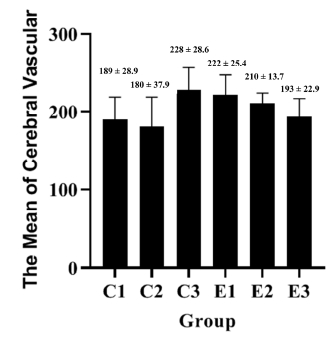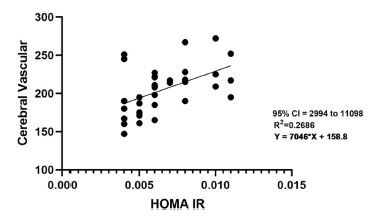
The Suppression Effect of Garcinia Mangostana L. Pericarp Extract on Cerebral Neovascularization in Type 2 Diabetic Mellitus Rats
Abstract
Mangosteen peel extract is a xanthone group, that plays an important role in anti-angiogenesis. This study investigated mangosteen peel extract on cerebral neovascularization in type 2 diabetes mellitus (DM) rats. This study used 36 rats, randomized into six groups: C1 (negative control); C2 (high fat diet (HFD) and mangosteen peel extract at 200 mg/kg BW); C3 (HFD and diabetic); E1, E2, and E3 (HFD, diabetic, and extract at 100, 200, and 400 mg/kg BW respectively). All groups were measured body mass index (BMI), homeostasis model assessment-insulin resistance (HOMA-IR) and β cell function (HOMA-B), and histopathological feature of cerebral vascular (CV). There were significant differences in BMI, HOMA-IR, HOMA-B, and the mean number of CV (all p < 0.05) among treatment groups. E1-3 groups had a significantly lower level of blood glucose and HOMA-IR, and a higher level of HOMA-B and BMI (all p < 0.05) which tends to reduce cerebral neovascularization. HOMA-IR independently had a positive effect to induce neovascularization of CV (p < 0.05, R2 = 26.8%). These findings suggested that mangosteen peel extract increased β-cell function sensitivity, and effectively suppressed insulin resistance, BMI, and cerebral neovascularization process in type 2 DM rats.
Keywords:
Cerebral neovascularization, HOMA-B, HOMA-IR, Mangosteen peel extract, Type 2 DM ratsIntroduction
Neovascularization is a key pathological characteristic of diabetic microvascular complications, particularly in the brain. Angiogenesis is one of the processes in neovascularization as a reparative response to ischemia.1 Angiogenesis denotes the de novo formation of capillaries from preexisting postcapillary venules and is largely initiated by hypoxic events.2 Interestingly, diabetes can cause neovascularization in which diabetes can increase the number of collaterals between middle and anterior cerebral arteries, the anastomoses within middle cerebral artery trees, the vessel density, and the level of brain-derived neurotrophic factors.3
Mangosteen (Garcinia mangostana L.) is a tropical fruit from Southeast Asia that is known to have been shown to reduce blood glucose levels in diabetic rats. It is also confirmed by other studies proved that mangosteen peel extract could reduce blood glucose levels and increase body weight in hyperglycemic Wistar rats.4 The main compound in mangosteen peel extract is xanthone, which has anti-inflammatory and antioxidant activity.5,6 Anti-inflammatory compounds in xanthone are useful in reducing various inflammatory mediators such as nuclear factor-kappa β (Nf-kβ), interleukin-6 (IL-6), interleukin-1β (IL-1β), soluble FMS-like tyrosine kinase-1 (Sflt-1), and tumor necrosis factor-α (TNF-α).5 Previous study showed that antioxidant played an important role in anti-angiogenesis.7 Antioxidant activities in didymin prevented vascular endothelial growth factor (VEGF)-induced endothelial cell proliferation, migration, invasion, sprouting, and capillary-like tube formation.8 This study aimed to investigate the effect of mangosteen peel extract on cerebral neovascularization in type 2 DM rats.
Experimental
General experimental procedures ㅡ This study was developed from previous study by using paraffin block of the brain tissue sample.9 Ethical approval number was 115/EC/H/KEPK/FK-UNDIP/VIII/2019 from the Medical and Health Research Ethics Commission Faculty of Medicine, Diponegoro University. Research samples were treated according to the experimental animal treat- ment protocol. The description of the experimental group was shown in Table 1.
The preparation of mangosteen peel extract ㅡ Mangosteen peel extract was prepared by drying 10 kg of fresh mangosteen peel until became 1 kg of mangosteen peel dried powder. The dried powder was macerated in 70% ethanol (4 L, 3 times) at room temperature for 24 hours. The 70% ethanol extract was obtained by evaporating and drying the macerated extract. The water was added to the crude extract and the insoluble solid was taken off to produce an alpha-mangosteen rich extract.9 Instead of HPLC, we extracted the xanthone content in mangosteen peel extract using Ultrasound Assisted Extraction (UAE) which has a more optimal result.10
BMI measurement ㅡ BMI was measured using the Lee index on the 4th week (after HFD feeding) and the termination day. The measurement of BMI using the Lee index used the formula: ({Body weight (g)1/3/Naso-anal length (cm)} × 103). Based on BMI calculation using Lee index, the rats were declared obese if they had a BMI of more than 300 g/cm3.
HOMA-IR and HOMA-B measurements ㅡ Blood glucose levels were determined by the glucose phenol 4-amino phenazone (GOD-PAP) method using a spectrophotometer.11 Blood glucose levels were measured after DM induction (pre-test). The rats were declared to have type 2 DM if they had a blood glucose level of more than 250 mg/dL. Blood glucose levels were measured again after the treatment was complete (post-test). In this experiment, insulin was measured by the Fine Test enzyme-linked immunosorbent assay (ELISA) method. Blood glucose levels and insulin levels were used to calculate insulin resistance and β-cell function by using HOMA-IR and HOMA-B. HOMA-IR was calculated using formula: (insulin (μU/mL) × glucose (nmol/L)/22.5)12 and HOMA-B was calculated using formula: (20 × insulin (μIU/mL)) / (glucose (mmol/L) – 3.5).13
Cerebral vascularization examination ㅡ The rats were terminated using alcohol ether after eight weeks and each rat was taken to the brain. The brains were harvested, followed by fixation in 10% neutral buffered formalin. Tissue samples were obtained from the brain's coronal section at the bregma level. Hematoxylin-eosin (HE) routine staining (Fisher Scientific PTE Ltd, Singapore) was performed for the formalin-fixed paraffin-embedded (FFPE) tissue. Histopathological analysis was examined with an Olympus BX41 microscope with Olympus DP26 camera (Olympus America Inc., NY, USA). CV was measured in the cortex area in six microscopic fields of 100x magnification on each sample. The calculation was performed on a CV with more than 37.56 μm length. 37.56 μm length indicated normal CV length that was obtained based on the C1 control group.
Statistical analysis ㅡ Data analysis using statistical software programs on a computer began with a normality test using the Shapiro-Wilk method. The result was compared between each group. The Wilcoxon test was used to compare the BMI of the rats before and after treatment. The distribution data of BMI, HOMA-IR, and HOMA-B were analyzed using the Kruskal Wallis to determine the differences across groups and the Mann-Whitney test was performed to determine the differences between groups. The One-Way ANOVA followed by the Post Hoc test was used to determine differences in CV between the control and experiment groups. The significance value was p < 0.05. The correlation between the histopathological feature of CV and HOMA-IR, HOMA-B, and BMI was analyzed with multiple linear regression. Statistical analyses were conducted by a computer program.
Result and Discussion
Fig. 1 showed the result of the mean BMI of Wistar rats. The highest increase in pre-test BMI was in the E3 group with an average of 327.25 ± 5.03, while the smallest mean was the C1 group with an average of 266.96 ± 5.59. The highest increase in post-test BMI was in the C2 group with an average of 346.95 ± 5.70, while the smallest mean was the E1 group with an average of 333.60 ± 6.34. In the C3 group, the BMI was decreased. The mean result in post-test BMI in the C3 group was 304.77 ± 7.49. The Wilcoxon test showed that there were significant differences in BMI before and after treatment. Furthermore, the Kruskal Wallis test was performed to determine the differences across groups. The Kruskal Wallis test showed that there were significant differences in the comparisons of all groups with p < 0.05. Furthermore, the Mann-Whitney test was performed to determine the differences between groups. The Mann-Whitney test showed that there were significant differences between groups with p < 0.05 except between E1 and E2 groups and C1 and E3 groups that did not show significant differences with p > 0.05.
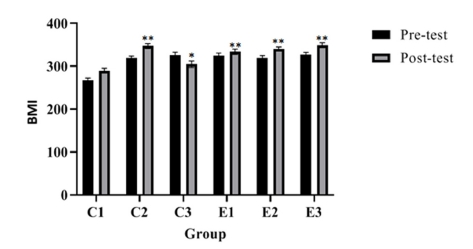
BMI chart values between six groups.*significantly different with C1, p < 0.05; **significantly different with C3, p < 0.05
The result of this study showed that mangosteen peel extract could increase BMI. This result was in concurrence with other studies that found the mangosteen peel extract increased body weight in diabetic rats.4,14 Increasing body weight will correlate with an increase in BMI levels in Wistar rats according to the BMI calculation formula using the Lee index. BMI reflected the mass of fat in the body and the mass of fat can be influenced by insulin levels.15 Insulin levels will increase the uptake of free fatty acids in the blood which directly increase fat deposits in the body.15 This study proved that mangosteen peel extract could increase BMI in Wistar rats. Mangosteen peel extract could increase BMI in C2, E1, E2, and E3 groups compared to the C3 control group that was not given mangosteen peel extract. This study found that Wistar rats morphologically were fat and active in the C2, E1, E2, and E3 groups compared to the C3 group in that Wistar rats looked thin and less active.
Fig. 2 showed the result of the mean of HOMA-IR. The smallest mean was the C1 group (0.004 ± 0.0001) and the highest mean was the C3 group (0.011 ± 0.0004). This result showed that the mean of HOMA-IR in experimental groups was lower than C3 group. The Kruskal-Wallis test showed that there were significant differences in the comparisons of all groups with p < 0.05. Furthermore, the Mann-Whitney test was performed to determine the differences between groups. The Mann-Whitney test showed that there were significant differences between groups with p < 0.05.
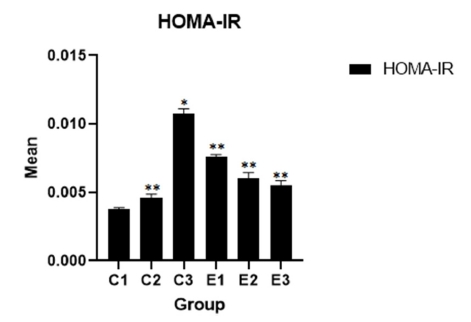
HOMA-IR chart values between six groups.*significantly different with C1, p < 0.05; **significantly different with C3, p < 0.05
This experiment showed that mangosteen peel extract could reduce insulin resistance. Data of HOMA-IR in E1, E2, and E3 groups were decreased compared with the C3 group. Insulin resistance in Wistar rats can be determined validly using HOMA-IR.16 Recent studies proved that mangosteen peel extract had antioxidant activity since contains xanthone, flavonoid, and phenolic that were effective to decreased glucose and insulin resistance, as well as increasing body weight and insulin sensitivity.12,17 This was also consistent with the result of decreased blood glucose level along with decreased insulin resistance in this study. Stimulation of insulin secretion after treatment with mangosteen peel extract may be due to a partial regeneration/repair of pancreatic β-cells or upregulation of the insulin synthesis in survived β-cells.
Fig. 3 showed the result of the mean of HOMA-B. The smallest mean was the C3 group and the highest mean was the C1 group. The mean result in the E1 group was lower than the E2 group and the E2 group was lower than the E3 group. This result showed that the mean of HOMA-B in experimental groups was higher than in the C3 group. The Kruskal Wallis test showed that there were significant differences in the comparisons of all groups with p < 0.05. Furthermore, the Mann-Whitney test was performed to determine the differences between groups. The Mann-Whitney test showed that there were significant differences between groups with p < 0.05.
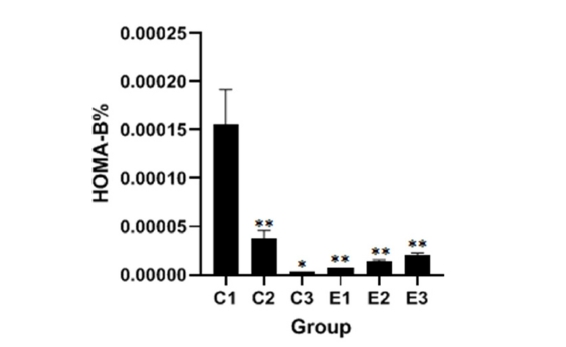
HOMA-B chart values between six groups.*significantly different with C1, p < 0.05; **significantly different with C3, p < 0.05
HOMA-B in C2, E1, E2, and E3 groups were higher than in the C3 group. It means that mangosteen peel extract has the potential to increase β-cells pancreas function in diabetic rats. In diabetic conditions, β-cell pancreas damage is caused by hypoxia due to oxidative stress.18
Previous studies reported that the expression of antioxidant defense genes in the diabetic condition was unusually low in the β-cell pancreas.18 Antioxidants xanthone in mangosteen peel extract might have the potential as a defense mechanism for the β-cell pancreas from oxidative stress in diabetes.17 Our findings were coherent with those previous studies, which indicated that mangosteen peel extract might have increased β-cell pancreas function in type 2 DM.
The results showed a significant difference in the mean number of CVs of all groups with One-Way ANOVA test (p < 0.05), but the Post-hoc test showed that there were no significant differences between groups with p > 0.05. Interestingly, the Post-hoc test results between groups C2 and C3 showed borderline significance (p = 0.05). Our study showed that the mean number of CVs in the obese group with DM (C2) was higher than the obese non-DM group (C3) and administration of mangosteen peel extract can reduce neovascularization in C2 (see Figs. 4 and 5). In further analysis, we can see that there was a trend of decreasing neovascularization as the dose of mangosteen peel extract increased at E1–E3 (see Figs. 4 and 5).
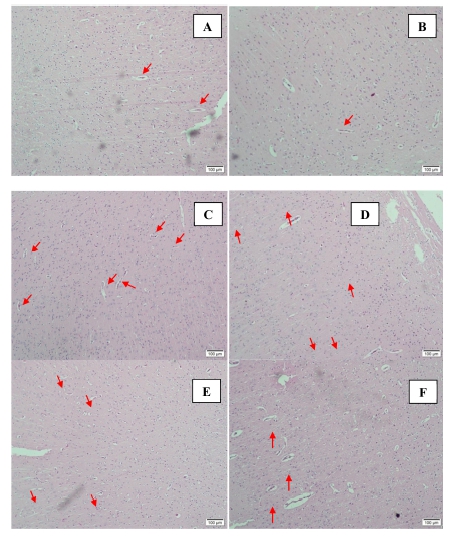
Cerebral neovascularization (red arrow) in C1 group (A), C2 group (B), C3 group (C), E1 group (D), E2 group (E), and E3 group (F).
The pathogenesis of DM associated with neovascularization is mediated by a state of chronic inflammation. DM causes a state of chronic inflammation,19 in which inflammatory cytokines can stimulate neovascularization.20 Through the anti-inflammatory effect possessed by mangosteen peel extract it has the potential to reduce neovascularization. This phenomenon is in line with a previous study that the administration of anti-inflammatory drugs (NSAIDs) could inhibit choroidal neovascularization.21 Wihastuti, dkk also showed that mangosteen pericarp ethanolic extract had a significant effect (p < 0.05) in decreasing vasa vasorum angiogenesis through anti-inflammatory processes.22 Alpha mangosteen has high antioxidants.23 The use of anti-oxidants can suppress neovascularization. A study conducted by Anwar, et al proved that mangosteen pericarp extract reduced the amount of angiogenesis through the mechanism of inhibiting ROS formation.24 This suggested that the anti-inflammatory and antioxidant effects of mangosteen peel extract play a role in reducing the formation of cerebral neovascularization in diabetic rats.
The correlation between histopathological features of CV and BMI, HOMA-IR, and HOMA-B was measured with multiple linear regression. The independent variables were BMI, HOMA-IR, and HOMA-B and the dependent variable was a histopathological feature of CV. T-Partial Bivariate test in Table 2 showed that there was a significant difference in both HOMA-IR (p = 0.001) and HOMA-B (p = 0.001) had a potential effect on the mean number of CV.

The correlation between histopathological features of cerebral vascular and BMI (g/cm3), HOMA-IR, and HOMA-B
The F-Simultaneous test in this study showed p = 0.007 and F = 5.774. The result of the R-square test showed 0.258, which means that 25.8% of CV was affected by HOMA-IR and HOMA B simultaneously. A partial t-test showed a significant difference in HOMA-IR (p = 0.007) but HOMA-B showed no significant difference (p = 0.644). The mean number of CVs can be determined by the equation: 155.076 + 49795 × HOMA-B + 7394 × HOMA-IR. Based on simple linear regression analysis, HOMA-IR independently affected the mean number of CV and obtained the equation CV = 7046 × HOMA-IR + 158.8. The results of this study indicated that HOMA-IR had a positive effect on the mean number of CV (R2 = 26.8%) (Fig. 6).
This study showed a significant correlation between HOMA-IR and the mean number of CVs. Coucha M, et. al demonstrated that insulin resistance in type 2 DM had profound effects on cerebral circulation.25 Insulin resistance affects the arterial architecture of CV causing pathological neovascularization resulting in impaired myogenic reactivity, neurovascular detachment, and endothelial dysfunction.25 This was following the results of this study which showed that the HOMA-IR value was comparable to the mean number of CV.
An antioxidant prevents VEGF-induced cell proliferation, migration, and invasion.8 Antioxidants also attenuated the VEGF-induced generation of ROS and activation of NF-κB.8 The present study did not show a significant difference between the C3 group and the C2, E1, E2, and E3 groups respectively. This study also showed that the mean number of CVs in the E1, E2, and E3 groups were still higher than in the C1 group, with insignificant differences between each group. However, this study had weaknesses and research limitations that could make the result of the study inconsistent with previous studies.
Weaknesses and limitations of this study were not being able to look at the definite cerebral neovascularization, no measurement was taken of confounding factors such as cholesterol level and blood pressure of Wistar rats which could be a risk factor for cerebral neovascularization, and the experimental of this study was not long enough so that the incidence of brain tissue ischemia in Wistar rats had not occurred.
In conclusion, mangosteen peel extract could effectively reduce HOMA-IR and HOMA-B levels, improve BMI, and reduce the number of cerebral neovascularization as well. This study proved that mangosteen peel extract has a potential effect to decrease insulin resistance, increase β-cell function sensitivity, increase BMI, and suppress the cerebral neovascularization process in type 2 DM conditions.
Acknowledgments
The authors are grateful to Grant Consortium No. 201-04/UN7.6.1/PP/2020 for financial support in this study.
Conflicts of Interest
The authors declare that they have no conflicts of interest.
References
-
Jaipersad, A. S.; Lip, G. Y.; Silverman, S.; Shantsila, E. J. Am. Coll. Cardiol. 2014, 63, 1–11.
[https://doi.org/10.1016/j.jacc.2013.09.019]

-
Persson, A. B.; Buschmann, I. R. Front. Mol. Neurosci. 2011, 4, 14.
[https://doi.org/10.3389/fnmol.2011.00014]

-
Li, W.; Prakash, R.; Kelly-Cobbs, A. I.; Ogbi, S.; Kozak, A.; El-Remessy, A. B.; Schreihofer, D. A.; Fagan, S. C.; Ergul, A. Diabetes 2010, 59, 228–235.
[https://doi.org/10.2337/db09-0902]

-
Taher, M.; Tg Zakaria, T. M.; Susanti, D.; Zakaria, Z. A. BMC Complement. Altern. Med. 2016, 16, 135.
[https://doi.org/10.1186/s12906-016-1118-9]

-
Mohan, S.; Syam, S.; Abdelwahab, S. I.; Thangavel, N. Food Funct. 2018, 9, 3860–3871.
[https://doi.org/10.1039/C8FO00439K]

-
Abate, M.; Pagano, C.; Masullo, M.; Citro, M.; Pisanti, S.; Piacente, S.; Bifulco, M. Pharmaceuticals (Basel) 2022, 15, 84.
[https://doi.org/10.3390/ph15010084]

-
da Silva Gomes, E. C.; Jimenez, G. C.; da Silva, L. C.; de Sá, F. B.; de Souza, K. P.; Paiva, G. S.; de Souza, I. A. J. Cancer 2014, 5, 143–150.
[https://doi.org/10.7150/jca.7439]

-
Shukla, K.; Sonowal, H.; Saxena, A.; Ramana, K. V. Vascul. Pharmacol. 2019, 115, 18–25.
[https://doi.org/10.1016/j.vph.2019.01.002]

-
Muniroh, M.; Nindita, Y.; Karlowee, V.; Purwoko, Y.; Rahmah, N. D.; Widyowati, R.; Suryono, S. Biomed. Rep. 2021, 15, 63.
[https://doi.org/10.3892/br.2021.1439]

-
Suryono, S.; Hadiyanto, H.; Yasin, M.; Widyowati, R.; Muniroh, M.; Amalia, A. E3S Web Conf. 2019, 125, 25006.
[https://doi.org/10.1051/e3sconf/201912525006]

-
Peniati, E.; Setiadi, E.; Susanti, R.; Iswari, R. S. J. Phys. Conf. Ser. 2018, 983, 1–6.
[https://doi.org/10.1088/1742-6596/983/1/012185]

-
Alizadeh-Fanalou, S.; Babaei, M.; Hosseini, A.; Azadi, N.; Nazarizadeh, A.; Shojaii, A.; Borji, M.; Malekinejad, H.; Bahreini, E. J. Ethnopharmacol. 2020, 248, 112331.
[https://doi.org/10.1016/j.jep.2019.112331]

-
Song, Y.; Manson, J. E.; Tinker, L.; Howard, B. V.; Kuller, L. H.; Nathan, L.; Rifai, N.; Liu, S. Diabetes Care 2007, 30, 1747–1752.
[https://doi.org/10.2337/dc07-0358]

- Husen, S. A.; Kalqutny, S. H.; Ansori, A. N. M.; Susilo, R. J. K.; Alymahdy, A. D.; Winarni, D. Biosci. Res. 2017, 14, 1238–1245.
-
Chan, C. P.; Koong, L. J.; Stern, J. S. Am. J. Physiol. 1982, 242, E19–E24.
[https://doi.org/10.1152/ajpendo.1982.242.1.E19]

-
Antunes, L. C.; Elkfury, J. L.; Jornada, M. N.; Foletto, K. C.; Bertoluci, M. C. Arch. Endocrinol. Metab. 2016, 60, 138–142.
[https://doi.org/10.1590/2359-3997000000169]

-
Watanabe, M.; Gangitano, E.; Francomano, D.; Addessi, E.; Toscano, R.; Costantini, D.; Tuccinardi, D.; Mariani, S.; Basciani, S.; Spera, G.; Gnessi, L.; Lubrano, C. Nutrients 2018, 10, 586.
[https://doi.org/10.3390/nu10050586]

-
Kim, K.; Park, S. M. Sci. Rep. 2018, 8, 2703.
[https://doi.org/10.1038/s41598-018-34613-2]

-
Ahmad, F. K.; He, Z.; King, G. L. Curr. Drug Targets 2005, 6, 487–494.
[https://doi.org/10.2174/1389450054021990]

-
Kota, S. K.; Meher, L. K.; Jammula, S.; Kota, S. K.; Krishna, S. V.; Modi, K. D. Indian J. Endocrinol. Metab. 2012, 16, 918–930.
[https://doi.org/10.4103/2230-8210.102992]

-
Yoshinaga, N.; Arimura, N.; Otsuka, H.; Kawahara, K.; Hashiguchi, T.; Maruyama, I.; Sakamoto, T. Lab. Invest. 2011, 91, 1277–1290.
[https://doi.org/10.1038/labinvest.2011.101]

-
Wihastuti, T. A.; Sargowo, D.; Tjokroprawiro, A.; Permatasari, N.; Widodo, M. A.; Soeharto, S. Vasc. Health Risk Manag. 2014, 10, 523–531.
[https://doi.org/10.2147/VHRM.S61736]

- Widowati, W.; Ginting, C. N.; Lister, I. N. E.; Girsang, E.; Amalia, A.; Wibowo, S. H. B.; Kusuma, H. S. W.; Rizal. Trop. Life Sci. Res. 2020, 31, 127–144.
-
Anwar, A. I.; Djawad, K.; Fitri, E. W. Pak. J. Nutr. 2016, 15, 745–751.
[https://doi.org/10.3923/pjn.2016.745.751]

-
Coucha, M.; Abdelsaid, M.; Ward, R.; Abdul, Y.; Ergul, A. Compr. Physiol. 2018, 8, 773–799.
[https://doi.org/10.1002/cphy.c170019]

